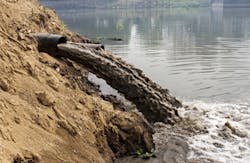The U.S. Environmental Protection Agency (EPA) will provide grants of $340 million to the state of New York and $229 million to the state of New Jersey for improvements to wastewater and drinking water treatment facilities impacted by Hurricane Sandy. The funding announced today will help storm-damaged communities in both states as they continue to recover from the damage caused by the storm on Oct. 29, 2012.
In the aftermath of Hurricane Sandy, the EPA says wastewater and drinking water treatment systems in New York and New Jersey were so severely damaged that some could not provide safe drinking water or treat raw sewage. The EPA funding is designed to give states the capacity to further reduce risks of flood damage and increase the resiliency of wastewater and drinking water facilities to withstand the effects of severe storms similar to Sandy.
The funds, which will be provided to the New York State Department of Environmental Conservation and the New Jersey Department of Environmental Protection, were authorized by the Disaster Relief Appropriations Act of 2013 and signed into law by President Obama on Jan. 29, 2013. In addition to protecting drinking water systems and maintaining water quality, the funding will provide for 6,000 short-term construction jobs.
The funds will be awarded as grants to the states and most will be given out to local communities as low or no interest loans that will be paid back to the states. Up to 30 percent of the money can be awarded as grants to communities rather than as loans.
Almost 60 percent of the funds will go to New York and about 40 percent of the funds will go to New Jersey for both the Clean Water and Drinking Water State Revolving Fund programs. The determination of how the funds should be allotted to New Jersey and New York was based on the percentage of the population living in impacted counties that FEMA designated for disaster assistance.
Projects will be selected by the states of New Jersey and New York using project priority ranking systems that are based on elements of the Clean Water Act, the Safe Drinking Water Act, the Disaster Relief Appropriations Act and state regulations. The highest rankings will be given to proposed projects that will most ensure water quality or provide the most protection to drinking water systems. Applicants may submit projects that incorporate green infrastructure, such as wetlands and detention basins to collect stormwater or natural features like sand dunes that are capable of mitigating storm water impacts; raise equipment from basements; and provide backup sources of energy that are renewable.
The states will review the proposed projects from impacted communities and then submit Intended use plans that include the recommended projects to EPA for review. The Intended use plans will be subject to public comment periods (30 days in New Jersey and 45 days in New York). Following these comment periods, EPA will evaluate the intended use plans and award the grants to the states.
The Disaster Relief Appropriations Act provided EPA with $500 million for the Clean Water State Revolving Fund and $100 million for the Drinking Water State Revolving Fund. The funding provided by the act is subject to sequestration, which has reduced the money available by $25 million for wastewater improvements and $5 million for drinking water. It also includes funding for EPA to administer the program.
The EPA says the funding complements the efforts of the Hurricane Sandy Rebuilding Task Force created by President Obama. The Task Force works closely with federal, state and local officials to help communities address rebuilding challenges, use funding as effectively as possible and provide oversight to ensure it is used as it was intended. Other federal support includes:
- The Federal Emergency Management Agency has obligated more than $1 billion to support state and local rebuilding efforts. It has also disbursed more the $1.3 billion directly to impacted families, covering eligible repair costs and meeting temporary housing needs.
- The U.S. Department of Housing and Urban Development has approved disaster recovery plans for New York and New Jersey, which means $3.5 billion in funding will be available for home and small business owners.
- The U.S. Small Business Administration has also provided more than $2 billion in disaster loans to homeowners and small businesses.
- The Federal Transit Administration’s Emergency Relief Program has allocated $2 billion in funding and the Federal Highway Administration’s Emergency Relief Program has allocated $584 million to repair and rebuild damaged infrastructure.
- The U.S. Department of Health and Human Services has allocated $474 million in Social Services Block Grants to help provide services to survivors and rebuild damaged health care facilities.



